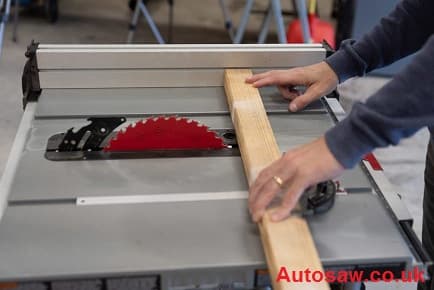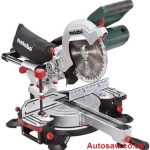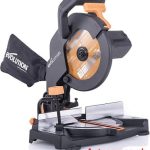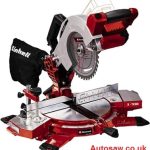As an Amazon Associate, I earn from qualifying purchases.

This guide is for anyone who wants to use a table saw. This guide will teach you how to use the table saw so that you can create beautiful, accurate, and consistent wood products.
A table saw consists of a flat table with a circular saw blade protruding through the surface. It also includes a rip fence for guiding the workpiece and a miter gauge for making angled cuts. Understanding the different parts of a table saw is essential before operating the tool.
Contents
Essential Safety Precautions
Safety should be your top priority when using a table saw. Before you start using the tool, make sure you wear appropriate safety gear, such as safety glasses, hearing protection, and a dust mask. Keep your work area clean and organized, and always follow these safety precautions:
- Read the manufacturer’s instructions and familiarize yourself with the table saw’s features and controls.
- Ensure the table saw is placed on a stable and level surface.
- Disconnect the power source before making any adjustments or changing the blade.
- Avoid loose clothing or jewelry that could get caught in the saw blade.
- Use a push stick or push block to keep your hands a safe distance from the blade.
Setting Up The Table Saw

Before you start using the table saw, it’s important to set it up properly. Follow these steps for a correct setup:
- Ensure the blade is parallel to the miter gauge slots and perpendicular to the table surface.
- Adjust the rip fence to the desired width and ensure it locks securely in place.
- Check that the blade height is appropriate for the cut you are about to make.
- Verify that the anti-kickback pawls and blade guard are properly installed.
Adjusting The Blade And Fence
Accurate adjustments of the blade and fence are crucial for precise cuts. Here’s how to adjust them:
- To adjust the blade angle, loosen the bevel lock and use a combination square or bevel gauge to set the desired angle.
- To adjust the rip fence, loosen the fence lock and align it parallel to the saw blade using a measuring tape or a dedicated fence alignment tool.
Making Straight Cuts
Making straight cuts is one of the fundamental tasks you’ll perform with a table saw. Follow these steps for a clean and accurate straight cut:
- Mark the cut line on your workpiece.
- Position the workpiece against the rip fence, ensuring it is flat against the table.
- Turn on the table saw and push the workpiece through the blade in a controlled and steady motion.
Making Angled Cuts
Table saws allow you to make precise angled cuts for various woodworking projects. Here’s how to make angled cuts:
- Adjust the blade angle according to your desired bevel cut.
- Use the miter gauge to guide the workpiece at the desired angle.
- Push the workpiece steadily through the blade, maintaining control and keeping your hands at a safe distance.
Ripping Stock
Ripping refers to cutting a workpiece along its length. Follow these steps for ripping stock on a table saw:
- Adjust the rip fence to the desired width of the cut.
- Position the workpiece against the rip fence and hold it firmly.
- Push the workpiece through the blade, maintaining a consistent feed rate and applying even pressure.
Crosscutting Stock
Crosscutting involves cutting a workpiece across its width. Follow these steps to crosscut stock on a table saw:
- Use a crosscut sled or miter gauge for greater accuracy and safety.
- Position the workpiece against the sled or miter gauge, aligning the cut line with the saw blade.
- Push the workpiece through the blade, keeping your hands clear of the blade’s path.
Using Accessories And Jigs
Table saws offer various accessories and jigs that can enhance your woodworking capabilities. Some common accessories include featherboards, push sticks, and sleds. Experiment with these accessories to improve safety and achieve better results in your projects.
Maintaining And Cleaning The Table Saw

Proper maintenance and cleaning ensure the longevity and optimal performance of your table saw. Consider the following maintenance tips:
- Regularly clean the table, fence, and blade to remove sawdust and debris.
- Lubricate moving parts according to the manufacturer’s instructions.
- Check the alignment of the blade, fence, and miter gauge periodically.
- Replace worn-out or damaged parts promptly.
Troubleshooting Common Issues
Even with proper maintenance, table saws may encounter issues over time. Here are some common problems and their potential solutions:
- Blade wobbling: Check if the blade is securely tightened and properly aligned.
- Burn marks on the wood: Adjust the feed rate, ensure the blade is sharp, and use a zero-clearance insert.
- Kickback: Maintain proper technique, use a splitter or riving knife, and ensure the workpiece is well-supported.
FAQs
What safety gear should I wear when using a table saw?
It is recommended to wear safety glasses, hearing protection, and a dust mask when operating a table saw.
Can I make bevel cuts with a table saw?
Yes, table saws allow you to make bevel cuts by adjusting the blade angle.
How often should I clean my table saw?
It is advisable to clean your table saw after each use to prevent sawdust buildup and maintain its performance.
What is kickback, and how can I prevent it?
Kickback refers to the sudden backward movement of the workpiece. To prevent kickback, use a splitter or riving knife and ensure proper feeding and support of the workpiece.
Are there any additional safety precautions I should take?
Yes, always disconnect the power source when making adjustments or changing the blade, and avoid wearing loose clothing or jewelry that could get caught in the blade.
Conclusion
Using a table saw can be both rewarding and challenging, but with practice and adherence to safety precautions, you can master this versatile tool. Remember to always prioritize safety, understand the different cuts you can make, and maintain your table saw regularly for optimal performance.





